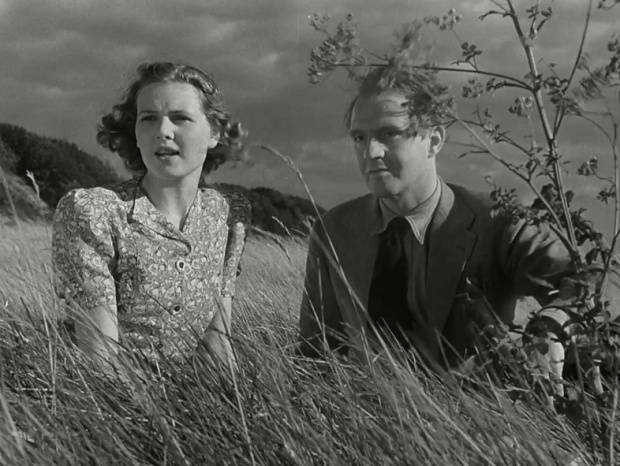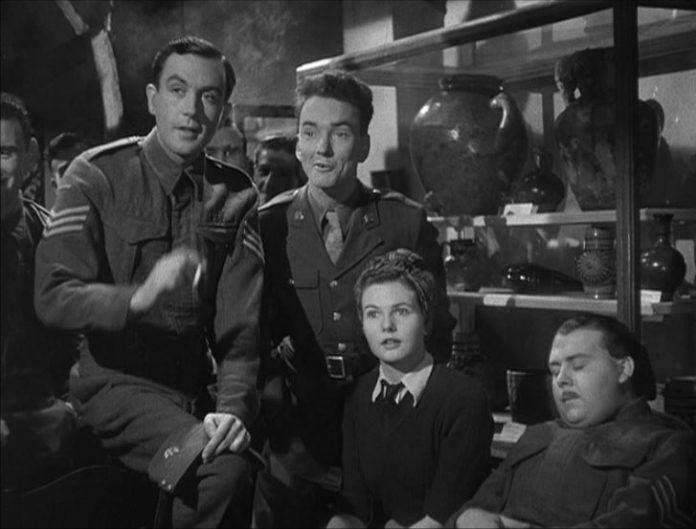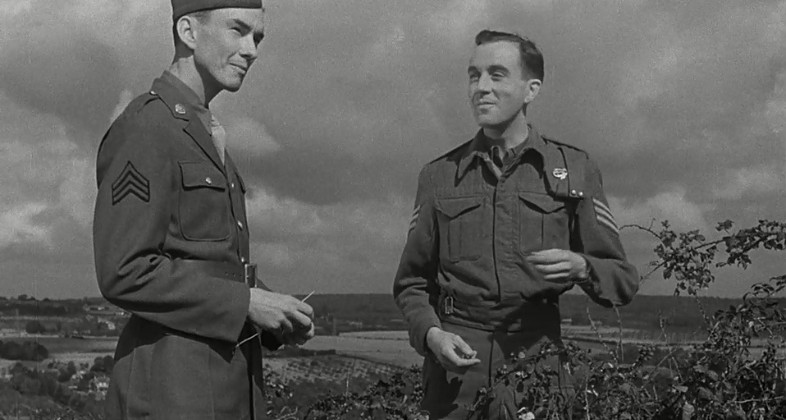This post is part of The World War II Blogathon, hosted by Cinema Essentials and Maddy Loves Her Classic Films. See the other posts here.
In A Canterbury Tale, Alison Smith (Sheila Sim), a Land Girl doing her bit in wartime Kent, goes for a walk on the Old Road pilgrims once travelled to Canterbury. She climbs up a hill, through field and forest, and stands at the top, the great cathedral visible in the distance. The wind blows in her hair; the grass rustles at her feet. Suddenly, she hears voices, laughter, horses’ hooves, jingling bells and a lute. Abruptly, the sounds vanish and she’s alone again.
The past isn’t past in A Canterbury Tale; it exists side by side with the present. In the darkest days of World War Two, when people were searching for certitude, Michael Powell and Emeric Pressburger looked at the English countryside and found something eternal: a nation’s soul.
The film follows three young people, modern-day pilgrims brought to Canterbury by the war. Bob Johnson, a sergeant in the US Army (played by real-life GI Sgt. John Sweet), is on his way to Canterbury one night when he accidentally gets off a stop too early and finds himself at the Chillingbourne train station. Bob is easy-going and good-natured, a stranger doing his best to understand sometimes abstruse English customs, but he’s American and that’s enough to ruffle the stationmaster’s (Charles Hawtrey) feathers. “Don’t tell me this whistle-stop is a town,” Bob says teasingly. “Chillingbourne was constituted a municipal borough in 1085, 407 years before Columbus discovered America,” is the prissy reply.
The next train isn’t until morning, so Bob walks into town with Peter Gibbs (Dennis Price), a British Army sergeant stationed at the local base, and another new arrival, Alison. The station master insists they escort her; no woman is allowed to walk alone at night, by order of the town magistrate, Thomas Culpeper (Eric Portman). They make their way through near darkness—there’s a blackout—when suddenly they’re ambushed by someone who pours glue on Alison’s hair. Bob and Peter give chase but the culprit escapes. The trio soon discover Alison is the eleventh victim of the “glue man”, a mysterious figure who targets women seen in the company of soldiers. Since the police seem hapless, Alison, Bob and Peter set out to unmask the glue man themselves.
Powell and Pressburger, the writing-producing-directing team known as the Archers, had made propaganda films before—most notably 49th Parallel, in which a Nazi U-boat crew (led by Eric Portman’s Captain) is stranded in Canada and resisted by everyone they meet. For A Canterbury Tale they created something more abstract: a meditation on British, specifically English, life. Bob, Peter and Alison go looking for the glue man but what they really find is England: a wondrous, mystical land, pulsing with life and eminently worth preserving.
Each of the trio has a burden to bear. Alison is mourning her boyfriend, recently killed in action. He would have married her, but his family thought he could do better than a shop girl. Bob has a girl back home whom he hasn’t heard from in seven weeks, despite countless letters. He can only conclude she’s ceased to care. Peter dreamed of being a church organist yet ended up playing in a cinema, a job which pays well at the expense of crushing his spirit.
All three of them begin to heal as they discover Kent and its history. The film is steeped in the past, beginning with extracts from Chaucer’s Prologue—narrated by Esmond Knight, who appears later on screen—and a woodcut illustration which comes to life, with millers, knights and wives of Bath all wending their noisy way to Canterbury. Much of the story takes place in the open air. Powell was born in Kent and the landscape is lovingly photographed, Erwin Hillier’s camera sweeping across rolling hills and verdant fields. Chillingbourne’s town hall and inn are timbered with solid oak that has stood for centuries and will stand for several more. (The town’s exteriors were filmed in Fordwich, Chilham and other Kentish villages. Local people were recruited as extras.)
Everything is permeated with a sense of continuity. A mystic as well as a historian and magistrate, Culpeper believes in communing with the earth and watching the clouds. Kent is to him one of the most beautiful places on earth—part of that beauty lies in appreciating the power of the past.
Kent’s distinct identity is shaped by its history, but the film is as much about what people share as what sets them apart. Bob is the first American soldier Chillingbourne has seen and it shows. The townspeople initially treat him like a walking stereotype (‘over-sexed, over-paid and over-here’). Yet the local wheelwright is astonished to learn that Bob knows all about timber. He should: his grandfather opened the first sawmill in his county in Oregon. A mutual language sparks mutual understanding and the wheelwright invites Bob over to lunch, a spontaneous gesture that might not have occurred to him otherwise.
The cast is superb. Sheila Sim is wonderful as Alison, one of the hundreds of women whose dreams were destroyed by the war and who simply carried on through their grief. A Canterbury Tale gave Dennis Price one of his best roles as Peter, an idealist turned cynic, whose hard edge only begins to soften around Bob and Alison. Eric Portman imbues Culpeper with all his considerable intensity, giving weight to the man’s missionary zeal. And Sgt. Sweet, who wasn’t a professional actor but a GI Powell spotted in an amateur play for the troops, is extraordinary as Bob. Culpeper embodies the film’s spirituality, but Bob represents its empathy. Sweet is straight-forward, warm and utterly sincere.
A Canterbury Tale may be the quietest of the Archers’ classics, certainly the least familiar to a wider audience. No matter. Those of us who know it love it for its lyricism, its generosity of spirit, its celebration of a particular place and people, its celestial score by Allan Gray, and its abiding conviction that that which separates us will always be less important than that which brings us together.



Yours is a lovely review of a movie that captivates and charms with each viewing.
Thank you so much! It’s one of my favourite films and it rarely gets talked about, even by Powell and Pressburger fans.
I agree with Patricia, what a wonderful review and tribute to this film. I’ve just recently discovered Powell/Pressburger but haven’t seen this one. I’ll try to track it down right away.
Thank you. I hope you enjoy it.
A lovely review of a wonderful film. I suppose it’s not quite among the most famous P+P films but it deserves to be. It’s my favourite of the black & white ones.
Thanks so much for bringing this to the blogathon.
Thanks. I really enjoyed writing this and I’m glad you love the film as much as I do. For me, it’s tied with ‘I Know Where I’m Going!’ as my favourite of the black and white films. ‘A Matter of Life and Death’ is my favourite over all.
Yes, probably mine as well, although Colonel Blimp is very close.
You’ve captured this wonderful film perfectly in your review. I always find this one a little difficult to describe because it’s more about emotion and atmosphere. Thanks so much for joining us for this blogathon.
I remember the first time I watched this, I was very little. I did not understand much. I heard a lot of positive reviews on this though. I think that I should watch it again.